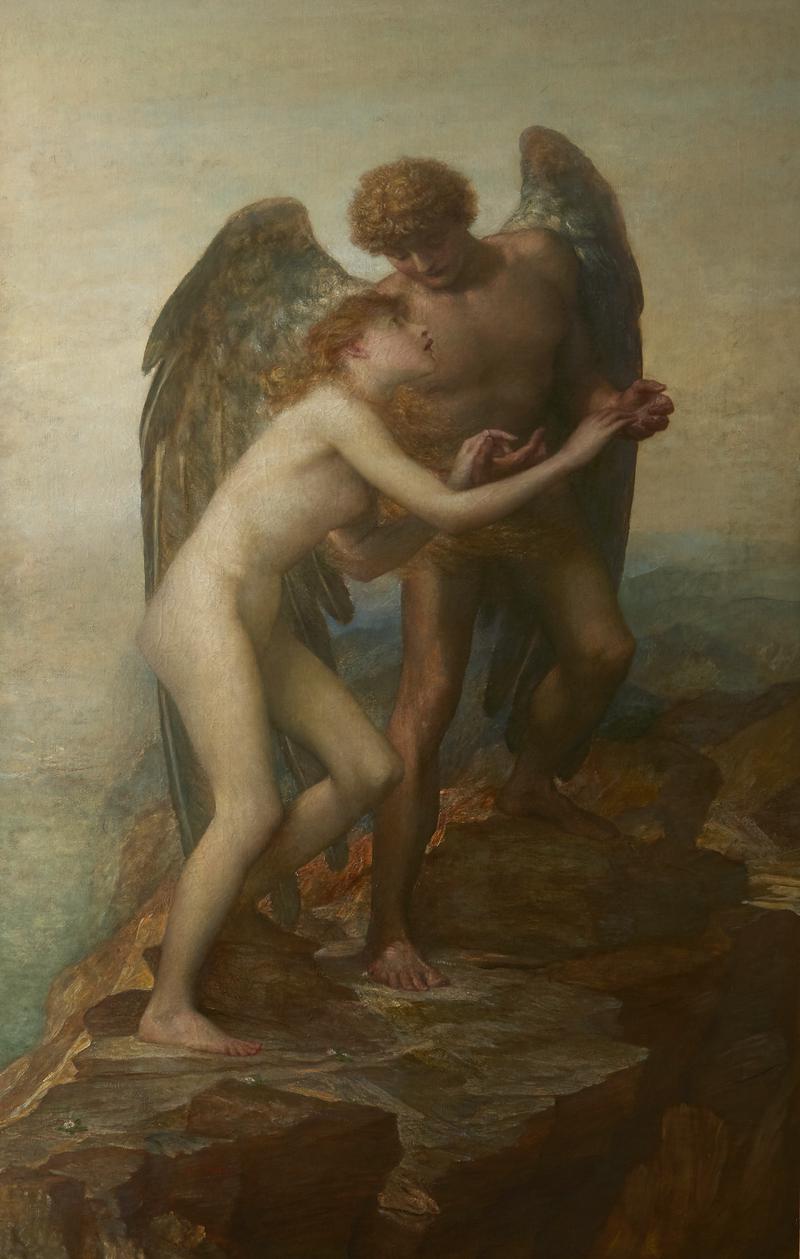Love and Life

Recently Exhibited
Watts Gallery - Artists’ Village, Compton, G. F. Watts Bicentenary Exhibition, June 2017- November 2018Additional Exhibition History
New York, Metropolitan Museum of Art, Paintings by G. F. Watts, R.A., 1884-5, no. 106Birmingham, Museum and Art Gallery, Collection of Paintings by G. F. Watts, R.A., and Edward Burne-Jones, A.R.A., 1885, no. 145
Nottingham, Museum and Art Gallery, Collection of Pictures by G. F. Watts, R.A., 1886, no. 33
Hanley, Staffordshire, 1889.
Chicago, World's Columbian Exposition, 1893, no. 486
Washington, D.C., The Corcoran Gallery, 1893-1902
Philadelphia, 1896
Washington, D.C., The White House, 1902-21 and 1929-32
Manchester City Art Gallery, Minneapolis Institute of Arts, and The Brooklyn Museum, Victorian High Renaissance, 1978-9, no. 30b (illustrated)
G. F. Watts is one of the most remarkable and versatile figures in Victorian art. During his long career of some seventy years, he made major contributions to history painting, the mural revival, portraiture, landscape, high Victorian classicism, symbolism, and the new sculpture. Watts, particularly with his more Symbolist paintings, dared to take risks and he ‘dragged English painting out of the eighteenth century and propelled it into the twentieth.’ (Jefferies.) During his lifetime, his work was well known and much admired on the Continent. Watts was seen as the ‘Old Master in the modern man’, his work sat well in the new Arts and Craft houses but his ‘haunting, almost supernatural style bypassed the constraints of his Pre-Raphaelite friends.’ (Gould, G. F. Watts, The Last Great Victorian, 2004.)
The composition of Love and Life seems to have been evolved by September 1882, and this picture was painted between February and June 1884. The theme had been treated in Elizabeth Barrett Browning’s (1806-1861) poem Life and Love. By the 1880s, Watts had the benefit of a secure reputation and he was able to explore grand themes in his allegorical paintings or, as he described them, ‘poems painted on canvas.’ Love and Life remains one of Watts’s most characteristic productions: an attempt to express a great moral truth in pictorial terms. Gould writes that Watts demonstrated that, ‘Life was not easy … nor should it be straight and narrow; but with justice as its mainspring it could be led “by tenderness and love up the steps of human conditions, the path from the baser existence to the nobler region of thought and character.” Love and Life, a frail nude maiden climbing the rocky path of life, was his message to the age.’ (Ibid. p. xiii).
Watts wrote, the design of the painting ‘has to do only with the purest abstractions’, and the figures are ‘only symbols’. His friend and biographer Mrs Russell Barrington, who undoubtedly discussed the subject with the artist, elaborated his meaning as follows: ‘Love is represented by the winged figure of a youth, and Life by that of a young girl, who, clinging to Love, is being guided by him over the rough places of a rocky precipice which both are ascending together. Love is leading the way, and helping Life, by his support and tenderness, to climb the difficult path - emblematic of the struggling conditions which, more or less, are the portion of all human existence. The half-extended wings of Love shade the rays of light from beating too fiercely on the delicate figure of Life. Love’s footsteps can be traced on the rocky ascent by the daisy flowers which have sprung up in his track. The atmosphere of the picture is bathed in the gold of light and the blue of space. As the figures ascend, the air becomes more golden with light … ‘.
Watts wrote of the conception of Love and Life: ‘I have for years been endeavouring to understand and illustrate a great moral conception of life, its difficulties, duties, pains and penalties, and I find that justice should be the mainspring of all our actions, and tenderness, pity, love should give the direction; I think my best composition is upon this subject; Love and Life, naked, bare life sustained and helped up the steps of human conditions, the path from the baser existence to the nobler region of thought and character. This religion of Love has been acknowledged from the earliest times – then with an uncertain utterance – but is now beginning to be acknowledged as the foundation of all. This is forgotten in the heat of personal impulses, and from forgetfulness has sprung almost all the injustice and misery in the world. This is what my painted parable would recall. I would suggest frail and feeble human existence aided to ascend from the lower to the higher plane, by Love with his wide wings of sympathy, charity, tenderness and human affection. Love is not intended to be either personal or carnal. It is the great love St. Paul speaks of which can be dwelt on and amplified to any extent.’ (G. F. Watts, quoted in M. S. Watts, George Frederic Watts: The Annals of an Artist’s Life, 1912, Volume III, pp. 227-8).
The painting was one of the most famous of all Watts’s images during his lifetime and one that he considered ‘my best composition.’ The ‘painted parable’, as Watts described it, sends the clear message that frail Life cannot reach its transcendent best and is lost without the steadying hand and help of charitable, altruistic, compassionate Love (rather than a physical passion) – a message that he hoped would reach a nation that he feared was entrenched in a materialistic, worldly void.
The allegory may also have been applicable to the marriage that Watts made with Ellen Terry. Wanting to save Terry from her ‘disreputable’ life on the stage, the high-minded Watts fell in love with her and with hints of Pygmalion, decided to marry her in 1864. He was forty-seven and his bride was seventeen. The ill-fated marriage broke down in less than a year and after a legal separation instigated by Watts, Terry was sent back to her parents and continued her successful stage career. The impact of Terry on Watts’s life and art was enormous and he continued to finish paintings of her for years after.
The motif of two interrelated bodies always fascinated Watts, and there are many examples from his oeuvre in which he tries out different dual figural interactions: The Good Samaritan, Paulo and Francesca, Jacob and Esau, Orpheus and Eurydice, Love and Death and the later Love Triumphant. With the two latter paintings, also major Watts allegories, there are thematic connections and each are again represented by several versions. Although the three designs form a trilogy of sorts, they vary considerably in concept and do not seem, like other paintings by Watts, to have been conceived as a formal triptych. While the present work is the prime original, the popularity of the composition and the importance Watts attached to it resulted in a number of later versions and seven versions are listed by Mary Watts.
Of all Watts’s pictures, Love and Life has the closest associations with America, although there was an element of tragi-comedy about its fortunes in that country. Watts included it in the exhibition of his work at the Metropolitan Museum, New York, in 1884. It received critical acclaim, and in 1893, Watts gave it to the American people, expressing a hope that it would become the nucleus of a national collection. It was accepted by an Act of Congress in 1894, and President Grover Cleveland intended to hang it in the White House. However, the nudity of the figures immediately came under attack from Mrs Emily D. Martin, National Superintendent of purity in literature and art for the Women’s Christian Temperance Union of the United States, and it was sent to the Corcoran Gallery instead. Nine years later (1902) Theodore Roosevelt had the picture returned to the White House and hung in the dining-room and it was seen there in a photograph, published in The New York Times, 17 December 1902. Mrs Martin then struck again. The presence of this ‘vulgar nude painting’, representing ‘two naked figures in atrocious postures, in the house of the Chief Executive’, she wrote in a Philadelphia newspaper, was ‘extremely objectionable to the women of this country. It cannot be that he has resurrected the work from its ten years of obscurity in an art gallery to flaunt any talk of “art for art’s sake” in our faces’. The President, however, stood fast; leading artists attacked her interference in the press; Sibyl Wilbur O’Brien, writing to The New York Times in 1902, protested against its removal from the Corcoran, saying that it was a loss to the public who could no longer see the vision of ‘love inspiring the fainting human soul.’ (Sibyl Wilbur O’Brien, letter to the editor, New York Times, 21 December 1902) and the picture remained in the White House, subsequently being hung over the fireplace in Woodrow Wilson’s study. The painting was later given to the Smithsonian Institution and it did not finally leave America until 1987.
Watts, of course, was horrified that his idealistic intentions had been so misconstrued. He believed, as did the Greeks, that the nude was the purest expression of high art. For him, nudity symbolised humanity while clothing lessened the impact of the portrayal of feeling. He appreciated Titian’s Sacred and Profane Love (1514) in which the naked woman symbolized celestial love, superior to her clothed companion who represented human love. The nude was much discussed at the time and Watts wrote, ‘The time must be future and real modesty when the mere absence of clothing is felt to be indecency, and I think it is one of the duties of Art to prevent such unnatural and unreal conclusion.’ (Gould, G. F. Watts, The Last Great Victorian, p. 36).



